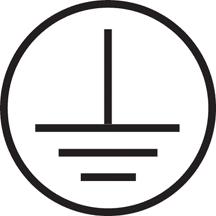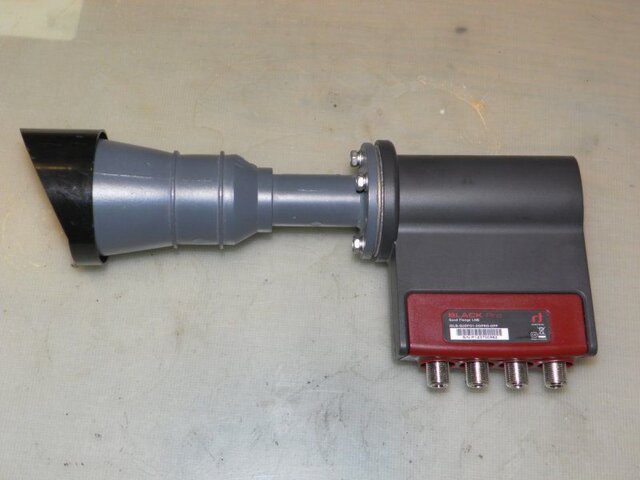So I have been having a lot of problems with my titanium dual LNB. i have two STB hook to it and when one STB is turn on it works fine but when both are on the signal drops and dont get anything at the STB. i have try both ports and does it on both. i did notice that LNB port 2 doesnt always work but port 1 does work only when one STB is hook to it. Do i need new LNB?
Titanium Dual LNB Problems :(
- Thread starter IntelPennny4
- Start date
- Latest activity Latest activity:
- Replies 51
- Views 8K
You are using an out of date browser. It may not display this or other websites correctly.
You should upgrade or use an alternative browser.
You should upgrade or use an alternative browser.
- Status
- Please reply by conversation.
If the LNBF works correctly if only one coax is connected at a time, I would rule out a LNBF defect and test for interaction between the two coax cables/STBs/AC power.
Are you using a multi-switch? Is the "0" skew marking stamp aligned with the dish polar axis (12 o'clock) or with 3/9 o'clock?
Are the two STBs located in different rooms or in the same room? If different rooms, test for power line interaction by running a temporary AC extension cord to power the STB, TV (and other connected AV devices).
Also, with the STBs connected as they are currently, check for potential voltages tested between the two coax cables (braid to braid, braid to center conductor and opposite braid to opposite center conductor) when disconnected from the LNBF and connected only to the STBs. Repeat the test with all AV devices connected.
Also note that sometimes tuners also will only interact when tuned on specific transponders and knock out a TP on the other STB.
Have noted many time over the years that multiple STBs located on different electrical sources can interact with multiple output LNBFs. Sometimes the can be identified to be the result of the home wiring, incorrect grounding, ground loops, voltage on neutral, a voltage detected between negative and ground, mismatch between tuners/STBs, etc.
Remedies include lifting grounds, installing a powered multiswitch, grounding/binding the dish to structure ground, etc.
Hope these ideas help you identify and slice the problem.
Are you using a multi-switch? Is the "0" skew marking stamp aligned with the dish polar axis (12 o'clock) or with 3/9 o'clock?
Are the two STBs located in different rooms or in the same room? If different rooms, test for power line interaction by running a temporary AC extension cord to power the STB, TV (and other connected AV devices).
Also, with the STBs connected as they are currently, check for potential voltages tested between the two coax cables (braid to braid, braid to center conductor and opposite braid to opposite center conductor) when disconnected from the LNBF and connected only to the STBs. Repeat the test with all AV devices connected.
Also note that sometimes tuners also will only interact when tuned on specific transponders and knock out a TP on the other STB.
Have noted many time over the years that multiple STBs located on different electrical sources can interact with multiple output LNBFs. Sometimes the can be identified to be the result of the home wiring, incorrect grounding, ground loops, voltage on neutral, a voltage detected between negative and ground, mismatch between tuners/STBs, etc.
Remedies include lifting grounds, installing a powered multiswitch, grounding/binding the dish to structure ground, etc.
Hope these ideas help you identify and slice the problem.
If the LNBF works correctly if only one coax is connected at a time, I would rule out a LNBF defect and test for interaction between the two coax cables/STBs/AC power.
Are you using a multi-switch? Is the "0" skew marking stamp aligned with the dish polar axis (12 o'clock) or with 3/9 o'clock?
Are the two STBs located in different rooms or in the same room? If different rooms, test for power line interaction by running a temporary AC extension cord to power the STB, TV (and other connected AV devices).
Also, with the STBs connected as they are currently, check for potential voltages tested between the two coax cables (braid to braid, braid to center conductor and opposite braid to opposite center conductor) when disconnected from the LNBF and connected only to the STBs. Repeat the test with all AV devices connected.
Also note that sometimes tuners also will only interact when tuned on specific transponders and knock out a TP on the other STB.
Have noted many time over the years that multiple STBs located on different electrical sources can interact with multiple output LNBFs. Sometimes the can be identified to be the result of the home wiring, incorrect grounding, ground loops, voltage on neutral, a voltage detected between negative and ground, mismatch between tuners/STBs, etc.
Remedies include lifting grounds, installing a powered multiswitch, grounding/binding the dish to structure ground, etc.
Hope these ideas help you identify and slice the problem.
When I was running two receivers off a single movable dish, I had a similar problem. Both receivers were the same (HDVR3500's). I switched one of the receivers out with a different brand, and the problem went away. Both receivers were on the same breaker, but in different rooms. Now that I'm running multiple dishes for each satellite, I can run the same two receivers without a problem. It doesn't take much to create odd problems with electronics.
BAD CONNECTOR BOYS!!!!!
Good deal, glad you found the problem.
well im back boys and the problem is too  i try to hook up just my hdvr3500 right to lnb. the lnb is label lnb 1 and lnb 2. lnb 1 works no problems at all. lnb 2 i get no signal at all. left it coneected to lnb 2 for about 3 hours and never saw a signal. try another box just in case and the same thing. WHAT NOW??
i try to hook up just my hdvr3500 right to lnb. the lnb is label lnb 1 and lnb 2. lnb 1 works no problems at all. lnb 2 i get no signal at all. left it coneected to lnb 2 for about 3 hours and never saw a signal. try another box just in case and the same thing. WHAT NOW??
well im back boys and the problem is tooi try to hook up just my hdvr3500 right to lnb. the lnb is label lnb 1 and lnb 2. lnb 1 works no problems at all. lnb 2 i get no signal at all. left it coneected to lnb 2 for about 3 hours and never saw a signal. try another box just in case and the same thing. WHAT NOW??
titanium dual LNB? Can you provide a part number?
All of the replies to you seem to be about LNBFs, not a duel LNB!
I happen to have a LNBF in front of me (I have never used one) and it has LNB on one and RCV on the other port.But it is still a LNBF!
The 8 foot sat dish I got from TECH 2000 (used) for $399 came with an LNBF with C-BAND on one port and KU on the other!
I have no idea what RCV is on that other LNBF!
Last edited:
A short coax goes from the ku lnb to the LNB port.The coax from the ReCeiVer goes to the RCV port.This allows single coax to do C and Ku,uses 22khz switching between the two.I have no idea what RCV is on that other LNBF!
what waylew said bro. yes i have a dual titanium lnb. model number is c2w-pll

- World's First Wideband PLL (Phase Lock Loop) C-band Dual Output LNBF (3.4 - 4.2Ghz)
not a dual LNB!
I have never used an lnbf, but I am sure you will get some help if the image I posted works!
waylew, did you mean that one coax from the RCV goes to the dish into a switch, and two short coax go to the two ports on that LNB? Or did you really mean to say LNBF?A short coax goes from the ku lnb to the LNB port.The coax from the ReCeiVer goes to the RCV port.This allows single coax to do C and Ku,uses 22khz switching between the two.
After I think about it, the switch could work with either of them! But I have never seen a LNB with two ports!
I have two of these LNBFs connected to powered multi-switches. Since they are PLL, they draw a bit more power than a DRO LNB/F. Cable and connectors are more critical due to the extra load. I suspect the vertical (14v) might suffer a bit more if there is a bad connection somewhere due to slightly higher amperage (current) than 18v horizontal. If both polarities are affected on one port and not the other using the same feedline, receiver, and power source; there could be an issue with the LNBF.
I have had a C2 (DRO) dual LNBF fail due to water seeping inside the enclosure, but managed to save it by taking it apart and cleaning it. Think I am still using it.
I have had a C2 (DRO) dual LNBF fail due to water seeping inside the enclosure, but managed to save it by taking it apart and cleaning it. Think I am still using it.
From your description I assume you are talking about a combo C/Ku LNBF.The Ku LNB is mounted on the back of the unit,the short coax would go from that to the LNB port.The coax from the receiver would then attach to the RCV port.The 22khz switch is built into the unit.This allows only needing one coax run out to the dish to get both C and Ku.I happen to have a LNBF in front of me (I have never used one) and it has LNB on one and RCV on the other port.But it is still a LNBF!
That is how my 10' Pinnacle is set up,when I installed the original dish in that location I had only run a single rg 11 out to it.

Intelpenny4, you have an LNBF!!!
- World's First Wideband PLL (Phase Lock Loop) C-band Dual Output LNBF (3.4 - 4.2Ghz)
not a dual LNB!
I have never used an lnbf, but I am sure you will get some help if the image I posted works!
People tend to call the LNBF's a LNB when referring to the above picture. The proper term is LNBF since the feed is incorporated into the unit. Each port on the LNBF allows for 2 receiver operation, which in my case, gives me one coax for each of the 2 8x1 switches I'm running to feed television to 2 receivers. Only one port at the time gets power when diseqc1.1 is selected and the proper port.
It makes for a switch time a bit slower than if all ports were powered simultaneously, which could overload the STB's power supply. I found that not all receivers respond the same to having a switch in the line, with some being grudgingly slow when switching from one port to another. Not all STB's are equal either. I was having trouble with a Linkbox 9000i switching to port two.
At times, it didn't want to work at all, so I changed out the switch and took care of the problem. I'm convinced that the Pansat switches I'm using aren't a bit on the quirky side. I recently ordered another brand just to try for the sake of comparrison.
Last edited:
I have two of these LNBFs connected to powered multi-switches. Since they are PLL, they draw a bit more power than a DRO LNB/F. Cable and connectors are more critical due to the extra load. I suspect the vertical (14v) might suffer a bit more if there is a bad connection somewhere due to slightly higher amperage (current) than 18v horizontal. If both polarities are affected on one port and not the other using the same feedline, receiver, and power source; there could be an issue with the LNBF.
I have had a C2 (DRO) dual LNBF fail due to water seeping inside the enclosure, but managed to save it by taking it apart and cleaning it. Think I am still using it.
one of the ports dont work at all but other one works good. maybe i need to be taking the heat sink off and taking a look inside. would filling the inside with dielectric grease and then seal it closed with clear silicone? would that hurt anything?? thanks
People tend to call the LNBF's a LNB when referring to the above picture. The proper term is LNBF since the feed is incorporated into the unit. Each port on the LNBF allows for 2 receiver operation, which in my case, gives me one coax for each of the 2 8x1 switches I'm running to feed television to 2 receivers. Only one port at the time gets power when diseqc1.1 is selected and the proper port.
Thank you for this information! I hope it helps Intelpenny4 ! He is the one that started this post!
I hope this helps me when I begin to set up the used dish from Tech 2000, It came with a LNBF with which I have no experience! I am used to LNBs and servo motors to change the polarity!
Likely best to contact Titanium and discuss with him. Not sure why one would need to do that. Maybe have a good look at the connector, maybe the center conductor came loose or is broken inside. I think there is a thread where someone took off the heatsink; if you need both ports, taking the cover off would give access to internals so you can at least check for moisture, continuity, etc. Since one port works normally, it kind-of suggests something other than moisture though. Good luck!
Last edited by a moderator:
- Status
- Please reply by conversation.
Similar threads
- Replies
- 3
- Views
- 57
- Replies
- 0
- Views
- 176
- Replies
- 13
- Views
- 1K
- Replies
- 6
- Views
- 1K
- Replies
- 10
- Views
- 310




